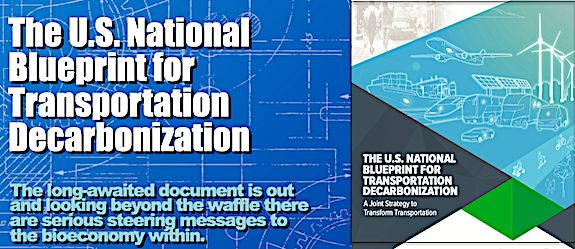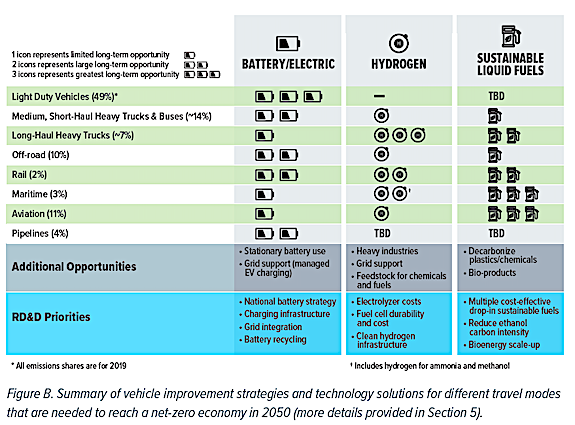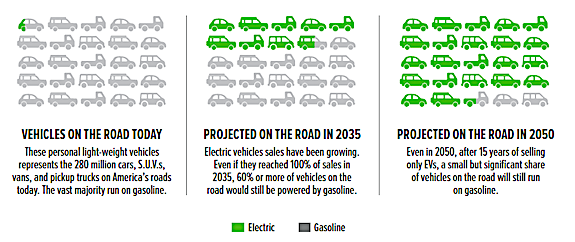The U.S. National Blueprint for Transportation Decarbonization

Next to a National Energy Solution, the next best thing is a U.S. National Blueprint for Transportation Decarbonization, and now we have one. As Deputy Assistant Energy Secretary Michael Berube described it as “a bold but achievable plan to largely eliminate greenhouse gas emissions from the transportation sector.” If so, it’s an historic moment, and something that the cross agency team behind this will point back to all their lives. You can download the complete Blueprint here.
What is the The Blueprint?
It’s a strategy for cutting all greenhouse emissions from the transportation sector by 2050. Jointly announced by U.S. Secretary of Energy Jennifer M. Granholm, U.S. Secretary of Transportation Pete Buttigieg, U.S. Secretary of Housing and Urban Development Marcia Fudge, and Environmental Protection Agency Administrator Michael S. Regan, the Blueprint will be followed by more detailed decarbonization action plans, to be developed and implemented by these agencies in cooperation with governments at the state, local, and tribal levels, philanthropic organizations, the private sector, and global partners.
Now thru 2030
Before 2030 – Turning the Tide on Transportation GHGs: Research and Investments to Support Deployment
|
|
|
|
|
|
|
|
|
|
|
|
2030 thru 2040
|
|
|
|
|
|
|
|
|
2040 thru 2050
|
|
|
|
The Specifics: Looking beyond the waffle and kerfuffle
OK, so you think the bullet points are vague. Good news, there’s more meat in the sections.

Light duty
Achieving 2050 net-zero-emissions goals will require transitioning new LDV sales to zero-emission EVs by the mid-2030s, and then rapidly replacing the legacy stock of higher-polluting fossil-based vehicles with zero-emission EVs.
Medium Vehicles
At COP27 on November 16, 2022, the United States joined the Global Memorandum of Understanding on Zero-Emission Medium- and Heavy- Duty Vehicles REF. First introduced at COP26, the Global MOU puts countries on a path to 100% new zero-emission MHDV sales by 2040 at the latest, with an interim goal of at least 30% new sales by 2030 REF.
Maritime
“Promising fuels and technologies that can support maritime decarbonization include:
a. Sustainable liquid and gaseous fuels. These include certain types of biofuels, ammonia, hydrogen, and methanol. Some biofuels and biofuel blends are drop-in replacements for traditional fossil fuels and offer the most substantial immediate GHG emissions reductions, as well as the opportunity to complement sustainable aviation fuel production and associated investments. Hydrogen, ammonia, and methanol are other promising fuel alternatives, but more research is needed to use and supply these fuels, ensure that they have low life-cycle emissions, and verify that they do not increase criteria pollutant emissions. “
Aviation
“Sustainable aviation fuels will be critical to the long-term decarbonization of aviation. SAFs are fully interchangeable, drop-in liquid hydrocarbon fuels with the same performance and safety as conventional jet fuels produced from petroleum. They can be deployed in existing infrastructure, engines, and aircraft. SAF can be created from renewable or waste materials and have been shown to reduce life-cycle GHG emissions by at least 50% relative to conventional jet fuel and potentially 100% if low-carbon technologies such as climate-smart agricultural practices, low-carbon electricity and hydrogen usage, or CCS are used. Efforts are ongoing to approve the use of 100% SAF in today’s fleet of aircraft, thus enabling the decarbonization of aviation without a change in its underlying infrastructure.”
The Backstory
Is it indeed historic? It was clear something was afoot last September when DOE, the US Departments of Transportation, Housing and Urban Development, and the Environmental Protection Agency, signed an MOU of cooperation in decarbonizing transport. More on that here. https://www.energy.gov/sites/default/files/2022-09/mou-doe-dot-epa-hud-final_09-15-2022.pdf
The agencies wrote last September: “Decarbonizing the transportation sector is a major challenge, and a major opportunity. The U.S. transportation sector generated 33% of US GHG emissions in 2019, generated over 70% of total petroleum demand in the U.S., and is a major cause of poor air quality, particularly affecting low-income populations, populations of color, and overburdened communities. Between 2010
and 2020, transportation has represented the second highest household expense, and is often considered a hidden cost of housing. Transportation allows businesses to receive goods and to transport products to consumers, connects people to jobs, schools, recreation, and health care, and puts Americans to work, as one of the largest industrial and manufacturing sectors in the economy. Creating a robust, clean, and well-functioning transportation system can create jobs, enhance equity, improve air quality, and help secure economic prosperity.”
The Bottom Line

We’re wondering if it’s a blueprint for a building that will ever be built on the timelines outlined in the document. Having noted that, it continues to signal that the growers and technologists now focused on supporting light-duty transport should be seeing their efforts as having reached a long, but emphatic END OF LIFE stage. Efforts should aim to diversify first-gen feedstocks to support maritime, aviation and heavy duty, where lift and range issues are more suited to hydrogen and liquid fuels. And, efforts should point towards providing renewable power, e.g. sustainable methane, that can support the expected numbers of EVs with carbon negative power that makes zero emission vehicles actually have zero emissions.
All of the government, some of the time
The pact is described by the Biden Administration as exemplifying “the Biden-Harris Administration’s whole-of-government approach to addressing the climate crisis and meeting President Biden’s goals of securing a 100% clean electrical grid by 2035 and reaching net-zero carbon emissions by 2050.” Um, whole of government? We wonder where the Department of Agriculture, Department of the Interior and Department of Defense are, exactly. But, we’ll let that pass.
Reaction from the Stakeholders
“The domestic transportation sector presents an enormous opportunity to drastically reduce emissions that accelerate climate change and reduce harmful pollution,” said U.S. Secretary of Energy Jennifer M. Granholm. “DOE is prepared to implement this Blueprint alongside our partners within the Biden-Harris Administration to ensure all Americans feel the benefits of the clean transportation transition: good-paying manufacturing jobs, better air quality, and lower transportation costs.”
“Transportation policy is inseparable from housing and energy policy, and transportation accounts for a major share of US greenhouse gas emissions, so we must work together in an integrated way to confront the climate crisis,” said U.S. Secretary of Transportation Pete Buttigieg. “Every decision about transportation is also an opportunity to build a cleaner, healthier, more prosperous future. When our air is cleaner; when more people can get good-paying jobs; when everyone stays connected to the resources they need and the people they love, we are all better off.”
“Under the leadership of President Biden, EPA is working with our federal partners to aggressively reduce pollution that is harming people and our planet – while saving families money at the same time,” said U.S. Environmental Protection Agency Administrator Michael S. Regan. “At EPA, our priority is to protect public health, especially in overburdened communities, while advancing the President’s ambitious climate agenda. This Blueprint is a step forward in delivering on those goals and accelerating the transition to a clean transportation future.”
“The people HUD serves deserve clean, affordable transportation options,” said U.S. Housing and Urban Development Secretary Marcia Fudge. “HUD is proud to join our federal partners at Energy, DOT, and EPA to ensure that clean transportation investments are made equitably and include communities and households that have been most harmed by environmental injustice. We look forward to working together to better align transportation, housing, and community development investments in these and other communities across the country.”
Category: Top Stories















